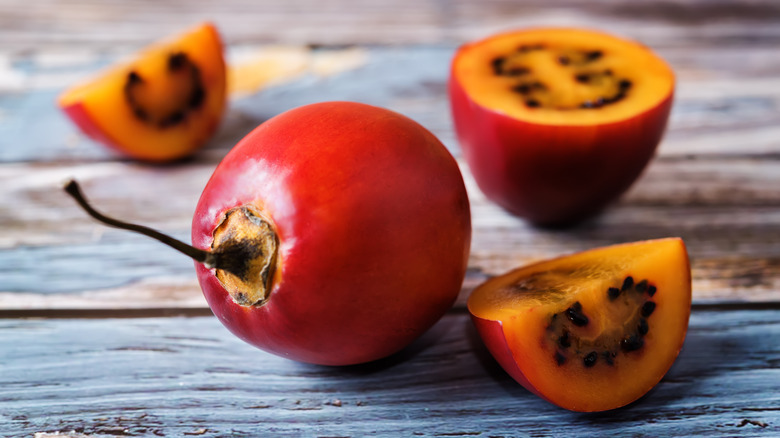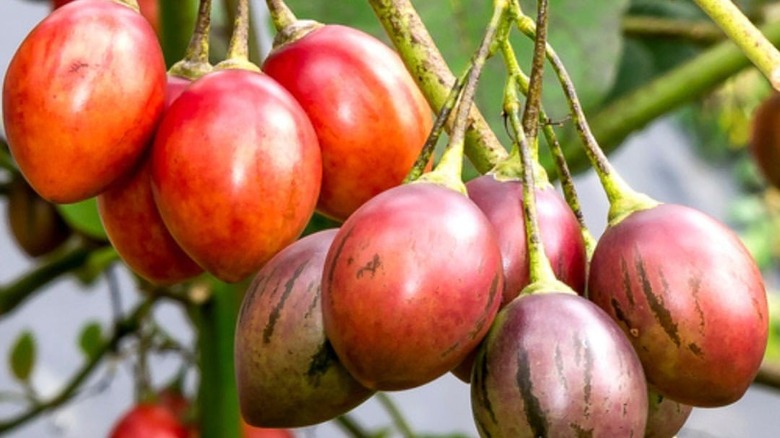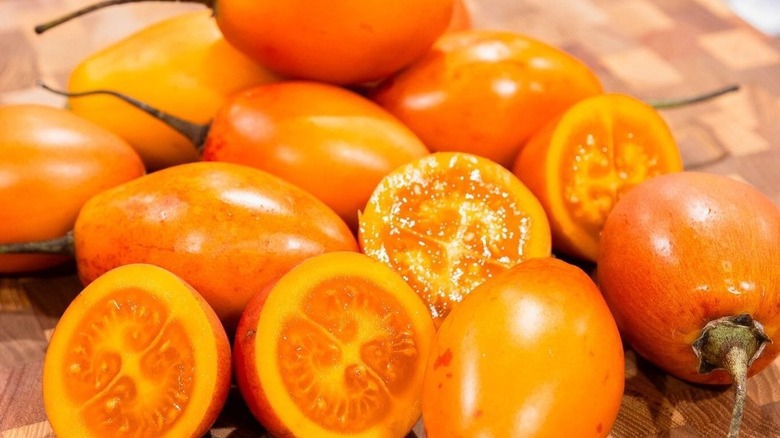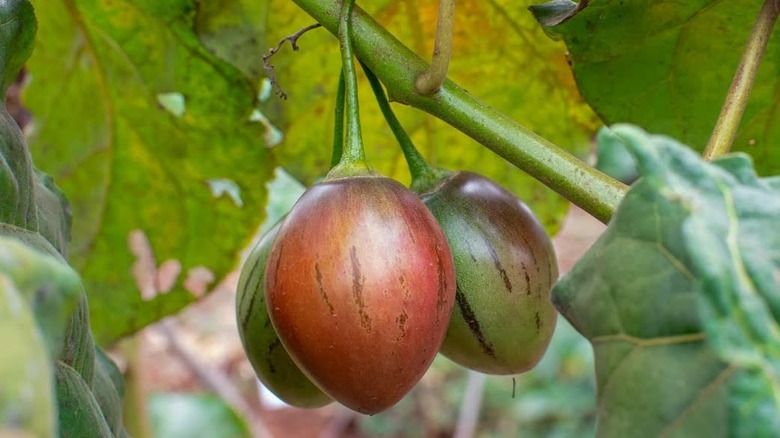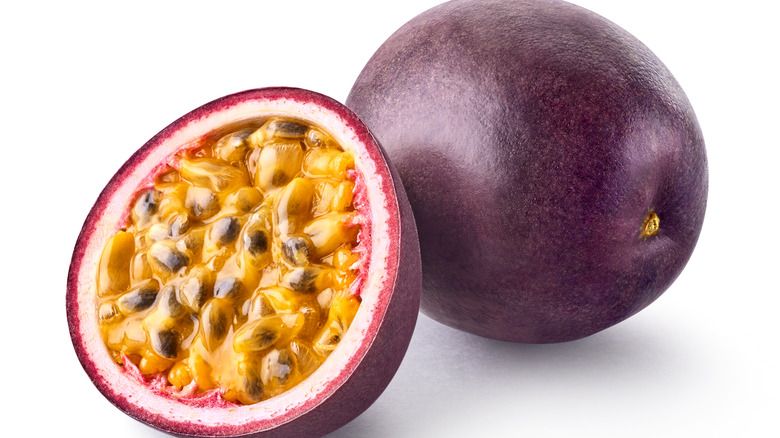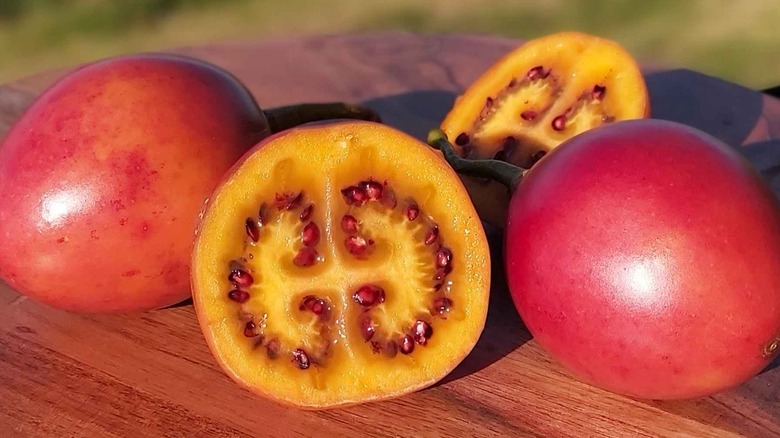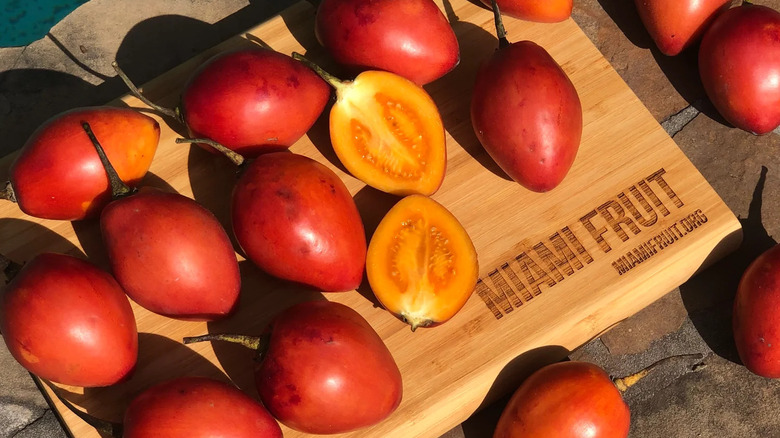What Are Bolivian Tree Tomatoes And How Are They Best Served?
One of the most popular vegetables, er, fruits, around, tomatoes have a chameleon-like flavor profile that complements a wide range of dishes. They give sandwiches a tasty tang, sauces a sweet-sour kick, and even go well with savory and spicy seasonings. There were 37 million metric tonnes of tomatoes consumed in 2022, 10% higher than the average during the years 2017 to 2019, per the Morning Star Co. Frankly put, the culinary world would be a lot duller without these vibrant-colored fruits.
With over 10,000 varieties, you'd be surprised to know that some, which claim to be tomatoes, are actually not tomatoes at all. Bolivian tree tomatoes are a rare type of fruit that carry the name and are similar in many ways, yet are completely distinct. Their unique flavor is just one example of the lesser-known world of fruit. As these rare beauties grow in popularity, it's the perfect time to do a detailed breakdown of Bolivian tree tomatoes and ways to incorporate them into everyday life.
What are Bolivian tree tomatoes?
Despite their names and similar appearances, Bolivian tree tomatoes are not actually tomatoes. They are members of the Nightshade family, yet that's where the similarities end. Bolivian tree tomatoes are known by many names, most notably tamarillos. Depending on where you are, people refer to them by tomate de arbol, lima tomate, or simply tree tomatoes. Tamarillo was coined by New Zealand to distinguish the fruit around 1970 and subsequently became the commercial standard.
It's unknown where tree tomatoes originated from, though it's speculated to be native to the Andes of Peru and other countries in South America. Though less common nowadays, many countries around the world cultivate tree tomatoes. They are available in three colors: red, gold, and amber-hued. The fruit flesh resembles a tomato and also has small edible seeds. Unlike tomatoes, the peels are usually removed due to being bitter and inedible.
How are Bolivian tree tomatoes grown?
The ideal growing conditions for Bolivian tree tomatoes are subtropical regions at high altitudes. Heights can vary based on location, with some countries as low as 1,000 feet, and others growing at altitudes above 6,000 feet — lower elevations work best in cooler climates. Temperatures above 50 F are generally most conducive, as the plant can easily frost and die. Tree tomatoes are shallow-rooted and require fertile, light soil. A gust of heavy wind can easily uproot a fruit-filled tree.
They are grown in every South American country except Costa Rica and Guatemala, and can also be found in Jamaica, Puerto Rico, Haiti, East Africa, Asia, the East Indies, Australia, and New Zealand. In America, tree tomatoes are primarily imported and only California and Florida are known to grow them. It typically takes one and a half to two years for trees to bear fruit; the average tree produces fruit for up to five years but can last as long as 12 with proper treatment. Though there are many varieties of tree tomatoes, the most common are Oratia Red, Rothhamer, Inca Gold, and Ecuadorian Orange.
Bolivian tree tomatoes are nutritious and delicious
As a member of the nightshade family, it's no surprise that tree tomatoes are loaded with nutrients. They are particularly rich in carbohydrates, and tree tomatoes are a good source of dietary fiber, too, helping to prevent constipation and maintain a healthy body weight while lowering the risk of diabetes and heart disease. If you're looking for a boost of vitamin C, they contain a life-supporting 29.8 milligrams for every 100 grams — that's nearly half the daily recommended intake for women and a third for men.
The list of benefits doesn't end there, as 100 grams of tree tomatoes can provide an impressive 321 milligrams of potassium. Potassium helps maintain normal fluid levels inside human cells, helps muscles contract, and supports normal blood pressure. Tree tomatoes are also excellent sources of magnesium, an important mineral that also helps sustain normal blood pressure, along with bone strength, and a steady heartbeat. Phosphorus is also present, another essential mineral that assists bones, teeth, and cell membranes.
Bolivian tree tomatoes vs. common tomatoes
Tree tomatoes are only comparable to common tomatoes based on their name and quasi-similar appearance. The skin is firm and waxy like mango skin yet inedible, whereas common tomato varieties can be consumed whole. The shapes differ as well; tree tomatoes resemble eggs, while tomatoes come in many shapes and sizes. You'll find that pulp is juicy with a tomato-y look, speckled with thin, circular, and almost flat black seeds. Common tomatoes typically have white, yellow, or greenish seeds, as black seeds can signify aging.
Color-wise, unlike pink reddish tomato pulp, tree tomato pulp can range from dark purple to red, yellow, and orange. When it comes to nutrition, tamarillos are a superior source of potassium, yet both offer a wide range of overall nutrients. The aromas are distinct too, as tomatoes have an earthy spiciness and tree tomatoes have a subtle plum-like fruity smell.
Bolivian tree tomatoes vs. passion fruit
Though it may seem an odd comparison, the distinctive taste of tree tomatoes is strangely similar to ripe passion fruit. Taste is, in fact, just about the only thing that these two fruits share. Unlike the tomato-y notes in tamarillos, passion fruit is citrusy with accents of melon, pineapple, or kiwi. Passion fruit is also believed to be native to South America and is indigenous to tropical and subtropical climates — particularly Brazil, Paraguay, and northern Argentina.
Thanks to its ideal growing environment, Brazil is the largest producer of passion fruit. Both fruits are hard to find in the U.S. and are usually only available in limited quantities. Passion fruit's pulp is noticeably distinct from tree tomatoes in consistency; it's bright yellow, gelatinous, and filled with seeds. Whereas tree tomato seeds are too bitter to enjoy, the entire interior of a passion fruit can be consumed. You can mainly find them in two varieties: purple and yellow — the former is usually sweeter.
Enjoy the tangy sweetness of Bolivian tree tomatoes
Sweet yet tart, tree tomatoes are a complex mixture of tomato, passion fruit, and kiwi. The tomato-y taste is perhaps the most prominent, though the fruity notes are also present, paired with noticeable tangy and citrusy accents, and ending with a subtle bitter and astringent aftertaste. Texture-wise, tree tomato pulp is tomato-like, yet doesn't get super soft as it ripens. The color of the pulp can impact the taste, too — the smaller amber-colored variety is usually sweetest, the red type is more citrusy, and the larger gold kind lands somewhere between.
The skin is tough with a disagreeable flavor you'll probably want to avoid, and though the outer layer of flesh is juicy, it also lacks flavor. The taste of tamarillos is also said to carry a strong sundried tomato flavor, that contrasts the sweeter notes, while adding balance to the overall experience.
Bolivian tree tomatoes are uniquely versatile ingredients
You can enjoy these rare beauties raw or incorporate them into smoothies, sauces, chutneys, curries, compotes, desserts, ice cream, salads, and more. In South America, they are used to make a popular Ecuadorian salsa named tamarillo ají. Locals drizzle this spicy staple atop empanadas, plantain chips, tamales, humitas, and pretty much any savory dish. Orange-colored and peppered with aromatics, it's a simple salsa made with tamarillos, ají amarillo (hot yellow peppers), garlic, onions, olive oil, cilantro, and lemon or lime juice.
Topping your tacos is a no-brainer, there are endless recipes that tamarillo salsa can elevate. Beyond fiery condiments, you can grill or roast tamarillos and add them to salads, meat dishes, and desserts. Grilled fruits provide the perfect smoky and sweet touch, too. If you enjoy infusing foods with flavors, poached tamarillos are right up your alley. Poaching will soften the texture enough for additives to impart flavor; it's also a great way to transform tamarillos into a sauce or compote. You can also swap water for poaching them in sweet tea.
Where to buy find Bolivian tree tomatoes
Sad news for U.S.-based folks, tree tomatoes are quite challenging to find stateside. The climate is one reason, as only a couple of states grow them. The majority are imported and only available seasonally. What's more, when they are available, it's only in limited quantities. An online search may garner local results, but more than likely, you will have to order them from a purveyor of foreign-grown fruits. Miami Fruits is one such business that grows tree tomatoes in South Florida's amiable climate. It offers a variety of tropical fruit boxes with a selection that rotates seasonally.
Tropical Fruit Box is another fruit box business that offers tree tomatoes. It's family-owned, also based in Florida, and has 35 years of experience in the exotic fruit space. As an uncommon fruit in the U.S., local farmer's markets are another fun and probable way to procure tree tomatoes — at least, it's more likely to find them there than at the supermarket. Talk to fruit vendors on your next visit to see when they are in season and may be available. Be prepared to shell out a pretty penny, as rarity comes at a price.
Purchase tamarillos on Miami Fruit for $127 (3 to 5 pounds), $177 (8 to 10 pounds), and $297 (16 to 20 pounds).
Purchase tamarillos on Tropical Fruit Box for $49 (3 pounds), $67 (5 pounds), and $79 (8 pounds).
